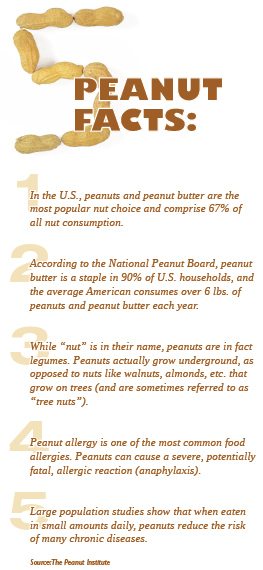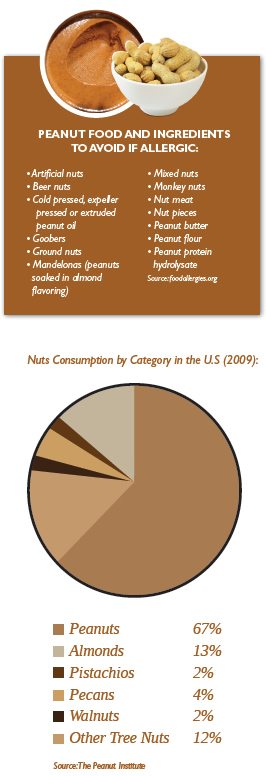Convenient, inexpensive, good for you and delicious: they have it all! Peanuts are the most popular and consumed nuts in the United States and can be found nearly everywhere. Perfect for a quick snack to cut a craving before grocery shopping or to boost your energy before a workout, a large selection of peanuts can be found at most gas stations, convenience stores and, of course, grocery stores. Not only do adults love these healthy treats, but research also shows that kids love the taste of peanuts. Recognized as a great source of protein and fiber, a handful of these nuts provide a highly nutrient food for less than 200 calories. The affordable and beloved groundnut is everywhere: from kids’ snacks to sweet and savory concoctions.
 The Story of the Peanut
The Story of the Peanut
According to the Peanut Institute, the peanut plant originated in South America, probably first domesticated and cultivated in the valleys of Paraguay. Spread by European explorers and traders, the plant eventually reached Asia, Africa and North America. Millions of peanuts are grown and consumed around the world. According to the USDA Foreign Agricultural Service, China, India and the U.S. are the top three producers of peanuts, having shares of 41.5%, 18.2% and 6.8% respectively of the overall world production. Peanuts started to be produced in large quantities in the 1900s due to the growing popularity of peanut butter, peanut candies and other peanut products; a need for more plant oils during World War I; and the research of Dr. George Washington Carver. Carver suggested that farmers rotate their cotton plants with peanut cultivation because while cotton drains nitrogen from the soil, peanuts put nitrogen back into the soil. Highly involved in the U.S. Department of Agriculture program, he encouraged the production and human consumption of peanuts and developed hundreds of recipes containing peanuts.
The Many Varieties of Peanut
While most people think of peanuts as nuts, they are in fact legumes and belong to a single plant family, Leguminosae. A legume is a type of plant with seeds that grow inside pods, such as peas or beans, and that provide the best source of concentrated protein in the plant kingdom. Unlike nuts, which are grown on trees, peanuts grow underground.
Although peanuts come in many varieties, four main types can be found in the United States:
Virginia Peanuts – also often called “cocktail nuts,” they have larger kernels.
Wonderful for? Processing. Particularly for salting, confection, and in-shell roasting because of their larger size.
Grown In? North Carolina, South Carolina, Virginia and Texas
Runner Peanuts – are the most widely consumed and of medium size; they have delicious flavor, great roasting characteristics and high yields.
Wonderful for? Producing peanut butters.
Grown In? Georgia, Alabama, Florida, Mississippi, Texas
and Oklahoma
Spanish Peanuts – have smaller kernels and are covered with a reddish-brown skin.
Wonderful for? Peanut candies, peanut and nut snacks and also peanut butter. They have a higher oil content than the other types, which make them the best for extracting oil.
Grown In? Texas and Oklahoma
Valencia Peanuts – are a sweet type of peanut covered by a bright red skin that usually contains three or more kernels in a longer shell.
Wonderful for? Boiling, roasting or consuming from their shells.
Grown In? New Mexico and Texas
 The Healthy Attributes of the Peanut
The Healthy Attributes of the Peanut
Peanuts are a wonderful food, rich in nutrients and flavor. Peanuts and peanut butter are part of the daily diet of millions of Americans. When it comes to eating peanuts, peanut butter and peanut oil, the research is convincing that they benefit health. The combination of fiber and protein in peanuts satiates hunger. Thus, eating peanuts helps manage weight and provide the key nutrients that are important to diets.
Peanuts are also natural energy boosters that contain healthy fats, proteins and antioxidants. Research shows that eating peanuts can decrease your risk of heart disease, diabetes and other chronic health conditions. A study published in the Journal of the American Medical Association found that people consuming two tablespoons of nuts or peanut butter at least five days a week can lower the risk of developing diabetes by almost 30 percent. Peanut butter is also full of the good kind of fat also known as monounsaturated fat that is heart-healthy and prevents belly fat that people get from carbohydrates or saturated fat.
The Peanut Allergy
Despite all their wonderful attributes, peanuts can’t be enjoyed by all. The peanut allergy is one of the most common food allergies that can cause a severe, potentially fatal reaction called anaphylaxis. To avoid such a reaction, peanuts and peanut products must be avoided and allergic patients are strongly recommended to always read ingredient labels to identify peanut traces. (Refer to the list of food to avoid those that contain peanuts.)
Childhood allergies to peanuts are on the rise. According to a FARE-funded study, the number of children in the U.S. with a peanut allergy more than tripled between 1997 and 2008. It is also estimated that 25%-40% of people who have a peanut allergy are also allergic to tree nuts. Peanuts and tree nuts often come into contact during manufacturing and serving processes. This is why it is often recommended for people who have a peanut allergy to avoid tree nuts overall. For businesses, it’s always important to disclose what contains peanuts.
Peanut Up Your Food!
For centuries, peanuts have been used in many culinary applications, including Chinese, African and Western cooking – in stews, sauces, mixed dishes, boiled or even plain – nourishing various populations with an enjoyable flavor. In the U.S., peanuts and peanut butter represent over two-thirds of all nut consumption and are considered an all-American favorite. The great advantages of using peanuts in the kitchen are their availability and affordability. Peanut oil is also becoming a popular option for cooking because of its healthy fats and high cooking temperature: more and more consumers are frying their Thanksgiving turkeys with peanut oil because of its high smoke point.
Peanuts are a traditional ingredient in Asian dishes, such as stir-fries and Thai noodles. Pureed peanut is also great to infuse nutty goodness into a variety of dishes such as soups, sauces, bread mixes, salsa recipes, salad dressings and pasta dishes. For those who like hummus, pureed peanuts and chickpeas are a great combination. On the sweet side, peanuts are commonly used for ice cream, brownie mix or cake batter. Peanut flour is an asset for pastry chefs because of its ability to act as a fat binder in confectionery products or to add flavor and extend shelf-life. Made from the highest quality peanuts, peanut flour contains 40%-50% protein, and is gluten-free and vegan. Other creative ways to use it include as a crumb topping for chicken and seafood or blended into smoothies and shakes to increase the flavor and protein content.
A long-time American favorite, the peanut offers countless healthy properties and natural nutrition to all populations and age groups. Found mainly in four different varieties in the U.S., peanuts enhance the flavor and boost the nutritional value of food dishes from breakfast and snacks to dinner and dessert. As a nut, oil, flour or butter, peanuts are a very versatile and tasty ingredient.
